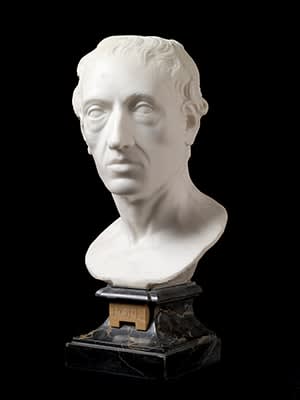

Circle of Louis Francois Roubiliac
Portrait of Alexander Pope (1688-1744), Mid- to late-eighteenth century
Marble
17 ½ in (44.5cm) high, including base.
The base inscribed ‘POPE’.
Philip Mould & Co.
To view all current artworks for sale visit philipmould.com Alexander Pope was one of the greatest poets of the Enlightenment and the originator of many of the English language’s...
To view all current artworks for sale visit philipmould.com
Alexander Pope was one of the greatest poets of the Enlightenment and the originator of many of the English language’s best phrases: his first major work, An Essay on Criticism, included the famous line ‘A little learning is a dangerous thing.’ This portrait derives from Roubiliac’s bust of 1740 [Fitzwilliam Museum], which in turn is based on his life bust in terracotta made in 1738 [Elton Hall]. It is unfinished at the back, suggesting that it was originally intended to be placed in a grotto or garden temple.
Pope seems to have enjoyed sitting for his portrait and many likenesses of him survive. He came from an artistic family (the miniaturist Samuel Cooper was his uncle) and later became friends with artists such as Charles Jervas, who taught him to paint, and Jonathan Richardson, who drew him dozens of times. In all, Pope sat to no less than twelve artists in his lifetime, resulting in nineteen or so different likenesses. He actively encouraged the dissemination of his own portrait, and frequently gave portraits of himself to his friends and supporters. But at the same time Pope was extremely sensitive about the portrayal of his image, for he was severely crippled, thanks to the contraction of Pott’s disease (tuberculosis of the bone) in his youth. He had a hunchback, a marked face, and distorted limbs. He never grew more than four and half feet tall and later wrote movingly of “this long disease, my Life.”
In a sense, therefore, Pope’s portraits, like the man, are contradictions. Pope, a Catholic by birth, grew up in a world where he was forbidden to go to university but became one of the greatest scholars of his age. In politics he was probably a Jacobite and at first flourished in the support of Tories like Bolingbroke and Harley, but eventually prospered as a Whig, and became a friend of Sir Robert Walpole. And in temperament he was universally admired for his wit and easy company but possessed the ability to alienate with ease, especially through his satirical works such as the Dunciad; he was a good hater. All this, though, is perhaps inevitable in the mind of someone who not only possessed arguably the most imaginative and creative mind of the eighteenth century, but whose life was a constant struggle against the circumstances in which he began.
Alexander Pope was one of the greatest poets of the Enlightenment and the originator of many of the English language’s best phrases: his first major work, An Essay on Criticism, included the famous line ‘A little learning is a dangerous thing.’ This portrait derives from Roubiliac’s bust of 1740 [Fitzwilliam Museum], which in turn is based on his life bust in terracotta made in 1738 [Elton Hall]. It is unfinished at the back, suggesting that it was originally intended to be placed in a grotto or garden temple.
Pope seems to have enjoyed sitting for his portrait and many likenesses of him survive. He came from an artistic family (the miniaturist Samuel Cooper was his uncle) and later became friends with artists such as Charles Jervas, who taught him to paint, and Jonathan Richardson, who drew him dozens of times. In all, Pope sat to no less than twelve artists in his lifetime, resulting in nineteen or so different likenesses. He actively encouraged the dissemination of his own portrait, and frequently gave portraits of himself to his friends and supporters. But at the same time Pope was extremely sensitive about the portrayal of his image, for he was severely crippled, thanks to the contraction of Pott’s disease (tuberculosis of the bone) in his youth. He had a hunchback, a marked face, and distorted limbs. He never grew more than four and half feet tall and later wrote movingly of “this long disease, my Life.”
In a sense, therefore, Pope’s portraits, like the man, are contradictions. Pope, a Catholic by birth, grew up in a world where he was forbidden to go to university but became one of the greatest scholars of his age. In politics he was probably a Jacobite and at first flourished in the support of Tories like Bolingbroke and Harley, but eventually prospered as a Whig, and became a friend of Sir Robert Walpole. And in temperament he was universally admired for his wit and easy company but possessed the ability to alienate with ease, especially through his satirical works such as the Dunciad; he was a good hater. All this, though, is perhaps inevitable in the mind of someone who not only possessed arguably the most imaginative and creative mind of the eighteenth century, but whose life was a constant struggle against the circumstances in which he began.
Provenance
Traditionally, the Throckmorton Family, Buckland Park, Faringdon, until c. 1908;The Fitzgerald Family, Buckland Park;
Brookes, Oxford, 13 June 1963
Bt. Roger Warner.
Literature
‘The Portraits of Alexander Pope’, by William Kurtz Wimsatt (London 1965), p.241, no.60.1Be the first to hear about our available artworks
* denotes required fields
We will process the personal data you have supplied in accordance with our privacy policy (available on request). You can unsubscribe or change your preferences at any time by clicking the link in our emails.

